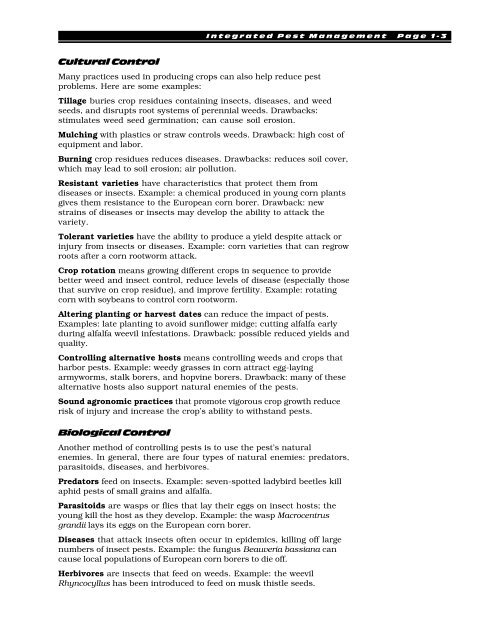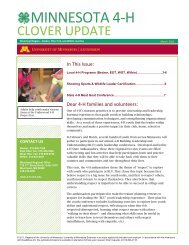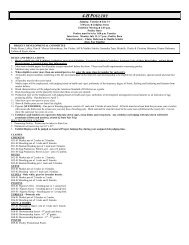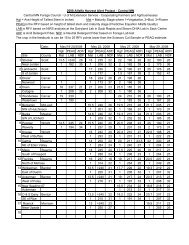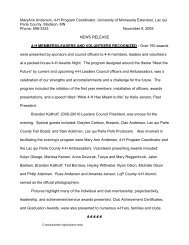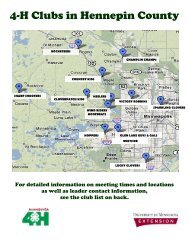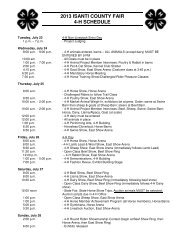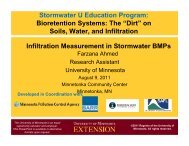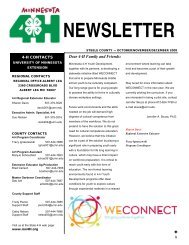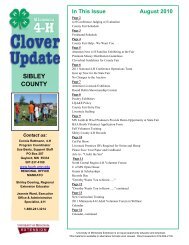Private Pesticide Applicator's Training Manual - University of ...
Private Pesticide Applicator's Training Manual - University of ...
Private Pesticide Applicator's Training Manual - University of ...
Create successful ePaper yourself
Turn your PDF publications into a flip-book with our unique Google optimized e-Paper software.
Cultural Control<br />
Integrated Pest Management Page 1-3<br />
Many practices used in producing crops can also help reduce pest<br />
problems. Here are some examples:<br />
Tillage buries crop residues containing insects, diseases, and weed<br />
seeds, and disrupts root systems <strong>of</strong> perennial weeds. Drawbacks:<br />
stimulates weed seed germination; can cause soil erosion.<br />
Mulching with plastics or straw controls weeds. Drawback: high cost <strong>of</strong><br />
equipment and labor.<br />
Burning crop residues reduces diseases. Drawbacks: reduces soil cover,<br />
which may lead to soil erosion; air pollution.<br />
Resistant varieties have characteristics that protect them from<br />
diseases or insects. Example: a chemical produced in young corn plants<br />
gives them resistance to the European corn borer. Drawback: new<br />
strains <strong>of</strong> diseases or insects may develop the ability to attack the<br />
variety.<br />
Tolerant varieties have the ability to produce a yield despite attack or<br />
injury from insects or diseases. Example: corn varieties that can regrow<br />
roots after a corn rootworm attack.<br />
Crop rotation means growing different crops in sequence to provide<br />
better weed and insect control, reduce levels <strong>of</strong> disease (especially those<br />
that survive on crop residue), and improve fertility. Example: rotating<br />
corn with soybeans to control corn rootworm.<br />
Altering planting or harvest dates can reduce the impact <strong>of</strong> pests.<br />
Examples: late planting to avoid sunflower midge; cutting alfalfa early<br />
during alfalfa weevil infestations. Drawback: possible reduced yields and<br />
quality.<br />
Controlling alternative hosts means controlling weeds and crops that<br />
harbor pests. Example: weedy grasses in corn attract egg-laying<br />
armyworms, stalk borers, and hopvine borers. Drawback: many <strong>of</strong> these<br />
alternative hosts also support natural enemies <strong>of</strong> the pests.<br />
Sound agronomic practices that promote vigorous crop growth reduce<br />
risk <strong>of</strong> injury and increase the crop’s ability to withstand pests.<br />
Biological Control<br />
Another method <strong>of</strong> controlling pests is to use the pest’s natural<br />
enemies. In general, there are four types <strong>of</strong> natural enemies: predators,<br />
parasitoids, diseases, and herbivores.<br />
Predators feed on insects. Example: seven-spotted ladybird beetles kill<br />
aphid pests <strong>of</strong> small grains and alfalfa.<br />
Parasitoids are wasps or flies that lay their eggs on insect hosts; the<br />
young kill the host as they develop. Example: the wasp Macrocentrus<br />
grandii lays its eggs on the European corn borer.<br />
Diseases that attack insects <strong>of</strong>ten occur in epidemics, killing <strong>of</strong>f large<br />
numbers <strong>of</strong> insect pests. Example: the fungus Beauveria bassiana can<br />
cause local populations <strong>of</strong> European corn borers to die <strong>of</strong>f.<br />
Herbivores are insects that feed on weeds. Example: the weevil<br />
Rhyncocyllus has been introduced to feed on musk thistle seeds.


